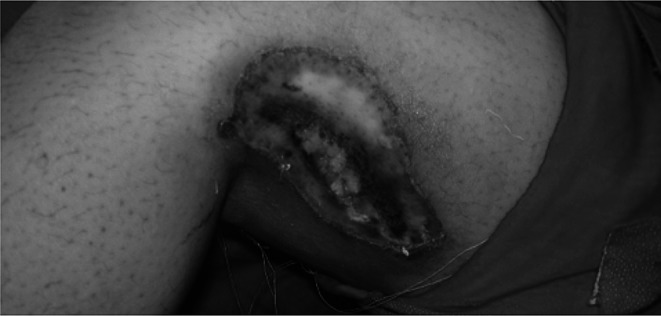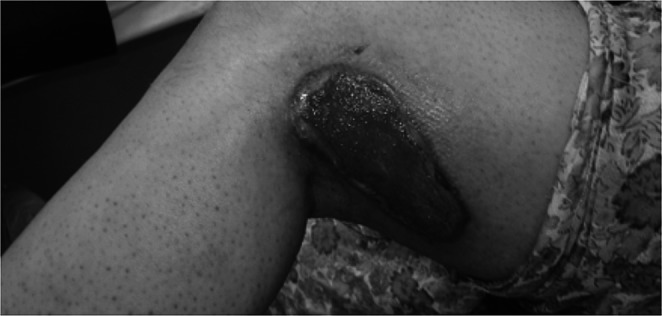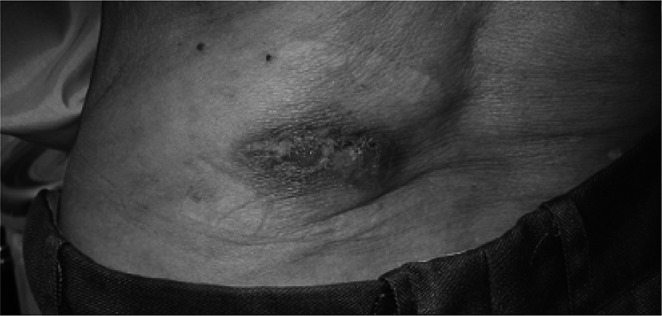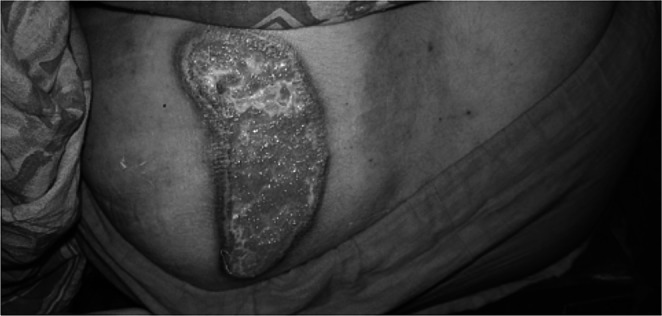Summary
This brief report highlights three cases of iatrogenic electrocautery burns with review of the relevant published literature. The aim is to prompt awareness among surgeons and theatre staff regarding this avoidable hazard associated with the equipment frequently used for the purpose of electrocautery. This may serve as a reminder to professionals to be cautious about the pitfalls that lead to such preventable injuries.
Keywords: iatrogenic burns, electrocoagulation, burn injury, electrocautery, electrosurgery
Abstract
Ce bref rapport met en évidence trois cas de brûlures iatrogènes provoquées par l’électrocautère, avec une revue de la littérature pertinente. L’objectif est d’inciter davantage la sensibilité des chirurgiens et du personnel du théâtre opératoire au sujet de ce risque évitable associé à l’équipement fréquemment utilisé dans les interventions d’électrocautère. Cela peut servir de rappel aux professionnels d’être prudents sur les pièges qui mènent à ces lésions évitables.
Introduction
Over the last century electrocautery has emerged as an imperative adjunct to surgery across the entire range of surgical disciplines. A diathermy machine converts electricity of the main supply (240V; 50 Hz) into high frequency current (>100,000 Hz) to minimize the risk of electrical shocks. In monopolar mode, the current from the diathermy enters the patient through the active electrode and exits through the grounding pad. In bipolar mode the current passes between the two prongs of the electrode without any significant flow through the patient and there is no need for the grounding pad.
Bovie deserves acknowledgement for his outstanding pioneering role in designing the first surgical diathermy machine in 1928. Since then cautery has been increasingly employed in surgery for cutting and coagulating, ensuring efficient haemostasis during surgery.1-4 It has become popular even for making skin incisions, given its quickness, effective haemostasis and associated lesser pain and minimal scarring.5,6
Although most of the newest diathermy machines are largely safe, the electric fields they generate are still inherently hazardous for the patient, operating surgeons, and theatre staff. They can cause burn injury, electrocution, operating room fire, smoke inhalation, and gene mutation.5-7 Several newer electromedical devices, laparoscopic diathermy and fiberoptic retractors are now emerging, and these pose the same hazards as cautery. The fire triangle consists of three elements necessary for initiation of an operating room fire, i.e. a heat source (e.g. electrocautery unit, laser), fuel (i.e. body tissues), and an oxidizer (supplemental oxygen).7-9
Iatrogenic cautery burns during surgery may result from one of the following four mechanisms: direct contact burns from the active electrode resting on the patient’s skin or contacting the operating staff; burns at the site of the grounding electrode; burns resulting from electrode heating of pooled solutions such as spirit; and burns occurring outside the operative field as a result of circuits generated between the active electrode and an alternate grounding source.10-16
We report our experience with three patients who presented to us with full-thickness deep burns following haemorrhoidectomy, surgery for coronary artery bypass grafting, and orthopaedic surgery. Our aim is to prompt awareness among the surgical staff regarding this avoidable hazard and promote a proactive attitude on the part of the surgical team towards prevention.
Case histories
Case I. A 21-yr-old lady presented to our outdoor department with a one-week history of haemorrhoidectomy under spinal anaesthesia in lithotomy position. The operating time was 1 hour. The grounding pad had been applied over the distal thigh on posterolateral aspect. The grounding pad was found to have a deep burn after recovery from surgery (Figs. 1, 1A). Our consultation was sought, and the patient was managed with excision and split thickness skin graft.
Fig. 1. This patient had haemorrhoidectomy under spinal anaesthesia in the lithotomy position. The loose-lying grounding pad under the burn area resulted in deep burn injury.

Fig. 1A. Same patient, full-thickness skin loss.

Case II. A 51-yr-old male who had triple vessel disease of the coronary arteries underwent successful coronary artery bypass grafting. His cardiac surgery proceeded uneventfully. The operating time was 3.5 hours. The grounding pad had been applied over the lower back, which was discovered to have a deep burn after recovery from surgery (Fig. 2). Our consultation was sought and the patient was managed with hydrogel dressings. Once discharged from the cardiac surgery unit, he was followed as an out-patient. He was advised to have wound closure, but did not consent to another surgical operation continued with conservative management and healed by secondary intention after two months.
Fig. 2. This patient underwent successful coronary artery bypass but continued to suffer from cautery burn for two months.

Case III. A 32-yr-old lady presented through the outpatients department with a two-week history related to a wound on her lower back. She had undergone orthopaedic surgery for a fractured radius and ulna under general anaesthesia. Her surgery had lasted for two hours and the grounding pad had been applied over the lower back (Fig. 3). Our consultation was sought, and the patient was managed with excision and split-thickness skin graft.
Fig. 3. This patient had orthopaedic surgery on the forearm under general anaesthesia and sustained iatrogenic burns in the grounding pad site on her lower back.

Discussion
Use of monopolar cautery and improper placement of the grounding electrode constituted the cause of electrocautery burns in our cases. While modern electrodes have been designed to minimize this complication, such burn injuries still continue to inflict patients and are often deep.17-23 Ignorance or negligence regarding standard safety protocols often underlies such mishaps. In a relatively recent attempt to abolish this complication, a noncontact electrosurgical grounding device has been developed, but its longterm safety benefits are yet not proven.22
In all our patients, the cause of burns was faulty application of the grounding pad, which failed to have good contact with the patients’ skin. When the grounding pad is loose, this may cause heat generation and sparking at the contact site, without providing an appropriate exit for the current to pass safely through the circuit. Several measures can be adopted to prevent these mishaps. The operating surgeon himself should have a proactive attitude and personally ensure that the grounding pad is adequately applied with firm contact to the skin over an adequate surface area. Preferably it should be secured to the skin with a crepe bandage. An area of at least 70 cm2 of firm skinpad contact should be ensured. Special care should be exercised to re-check the position of the pad if the patient’s position is changed intra-operatively. One may employ the newer grounding pads with adhesive properties that firmly attach them to skin. The diathermy machine’s active alarm system will also help to limit the extent of the resultant burn injury. If a bipolar cautery is employed the risk of grounding pad burns can be eliminated altogether.
All our patients had deep burns. One patient who had cardiac surgery was managed conservatively with dressings while two had resurfacing of their wounds with splitthickness skin grafts. Sanders et al.24 reported a case of deep burns from the grounding pad in a patient undergoing shoulder arthroscopy. The literature has reported several other cases of cautery burns occurring during different various surgical procedures such as cardiac surgery, orthopaedics, and neurosurgical procedures.
Most of these were deep burns and required plastic surgical interventions.25-27
Mundinger et al.10 reported a case of forehead burns in a patient with titanium plates in her skull bones previously implanted as part of treatment for her skull anomalies. The grounding pad was placed on the lateral thigh, however burns occurred at her forehead as she was positioned prone and circuit generated between the active electrode and an alternate grounding source (i.e. indwelling hardware). This case exemplified the alternate-site or capacitative coupling burns wherein an aberrant intra-operative circuit is generated by equipment contacting the body of the patient. This results in burns at sites of contact remote from the operative field and the normal grounding pad. Such injuries may occur on areas of un-insulated surgical table contacting the patient, electrocardiographic leads, temperature probe insertion sites, and sites of placement of various other monitoring devices.28-31
There is a recent growing recognition of the added danger posed by the combination of supplemental oxygen and electrocoagulation in facial surgery. Engel et al.8 have reported three such patients sustaining burn injuries while undergoing facial plastic surgery under conscious sedation and supplemental oxygen. One prudent way is to avoid using supplemental oxygen without proper endotracheal intubation altogether as the oxygen-enriched atmosphere contributes to the fire as an oxidizer.2,8,32-35
The use of alcohol and spirit based skin preparation solutions is another risk factor for fires and burn injuries in the operating room. The solution, if not evaporated before employing the cautery, will lead to fire and burn injury. The electrosurgical diathermy unit is the usual source of heat to ignite the flammable substance, although lasers and fiberoptic lights can also be potent heat sources. The fuel is provided by alcohol-based prep solution, drapes, sponges, and endotracheal tubes. In the presence of a high oxygen environment, all of these substances can burst into flames and burn intensely. When alcohol-based prep is used and the patient is draped before the solution is completely dry, alcohol vapors can be trapped and channelled to the surgical site or the solution wick may get into the surrounding linen, where a heat source can ignite the vapours.11,30,31,36,37 When using alcohol-based skin preparations a few precautions should be strictly adhered to. The surgeon must wait for at least 3 minutes for the solution to evaporate and the skin is wiped with a cotton swab before draping the surgical site; shaving the skin to prevent pooling of solution in the hair; effectively drape the patient with a clear plastic adhesive drape to prevent collection of flammable vapors beneath the drapes. The best policy is to avoid these flammable substances and use the much safer solutions of povidone iodine and chlorhexidine.
An electrocautery burn is a medical error which also has medicolegal and ethical implications. There is a long list of such errors, from simple misdiagnosis to more serious harm that may culminate in the patient’s death. Such errors may emanate from negligence or system failure. Unfortunately such errors continue to occur in every part of the world. Ideally the professional staff and hospital administration concerned should ensure patient safety by preventing such mishaps and compensate for the harm that ensues to the patients.38-41 Reporting such errors is imperative as this will ensure safer management of future patients by sensitizing the professionals involved, leading to the adoption of preventive strategies.42-45
Conclusion
We conclude by reiterating the fact that as long as we continue to use the available conventional unipolar electrocautery, the hazard of burns to patients particularly at the grounding pad site must be borne in mind. The operating surgeon should be mindful of the risks involved and be proactive to ensure the patient’s safety.
Acknowledgments
Conflict of interest. The Authors of this paper hereby declare that they have no conflict of interest and that no funding has been involved.
References
- 1.Sudhindra TV, Joseph A, Hackingt CJ, et al. Are surgeons aware of the dangers of diathermy? Ann R Coll Surg Engl. 2000;82:31–2. [PMC free article] [PubMed] [Google Scholar]
- 2.Meneghetti SC, Morgan MM, Djohan R. Operating room fires: Optimizing safety. Plast Reconstr Surg. 2009;123:431. doi: 10.1097/01.prs.0000282729.23202.da. [DOI] [PubMed] [Google Scholar]
- 3. Cuschieri, A Giles, GR Moossa, AR , editor. “Essential Surgical Practice”. (4th ed.) Butterworth Heinemann; London: 2000. Surgical craft and technology; pp. 37–68. [Google Scholar]
- 4.Cushing H. Electrosurgery as an aid to the removal of intracranial tumours. Surg Gynecol Obstet. 1928;47:751–84. [Google Scholar]
- 5.Khullar PN, Anand VJ. To compare the superiority of electrocautery over the traditional scalpel for skin incisions. J Surg Research. 2004;121:341–6. [Google Scholar]
- 6.Makama JG, Ameh EA. Hazards of surgical diathermy. Niger J Med. 2007;16:295–300. doi: 10.4314/njm.v16i4.37325. [DOI] [PubMed] [Google Scholar]
- 7. Eisele DW, , editor. “Complications in Head and Neck Surgery”. St. Louis, Mo: Mosby-Year Book; 1993. Head and neck surgical fires; p. 312. [Google Scholar]
- 8.Engel SJ, Patel NK, Morrison CM, et al. Operating Room Fires: Part II. Optimizing Safety. Plast Reconstr Surg. 2012;130:681. doi: 10.1097/PRS.0b013e31825dc14a. [DOI] [PubMed] [Google Scholar]
- 9.Meltzer HS, Granville R, Aryan HE. Gel-based surgical preparation resulting in an operating room fire during a neurosurgical procedure: Case report. J Neurosurg. 2005;102:347–9. doi: 10.3171/ped.2005.102.3.0347. [DOI] [PubMed] [Google Scholar]
- 10.Mundinger GS, Rozen SM, Carson B, et al. Full-thickness forehead burn over indwelling titanium hardware resulting from an aberrant intraoperative electrocautery circuit. Eplasty. 2007;8:1–7. [PMC free article] [PubMed] [Google Scholar]
- 11.Marwah S, Singla SL. Spirit-induced cautery burns: An unusual iatrogenic injury. The Internet Journal of Surgery. 2010;22 [Google Scholar]
- 12.Daane SP, Toth BA. Fire in the operating room: Principles and prevention. Plast Reconstr Surg. 2005;115:73–5. doi: 10.1097/01.prs.0000157015.82342.21. [DOI] [PubMed] [Google Scholar]
- 13.Pollock H. Operating room fires. Plast Reconstr Surg. 2009;123:431–2. doi: 10.1097/PRS.0b013e31817c6b90. [DOI] [PubMed] [Google Scholar]
- 14.Vedovato JW, Polvora VP, Leonardi DF. Burns as a complication of the use of diathermy. J Burn Care Rehabil. 2004;25:120–3. doi: 10.1097/01.BCR.0000105047.29499.20. [DOI] [PubMed] [Google Scholar]
- 15.Lord MJ, Maltry JA, Shall LM. Thermal injury resulting from arthroscopic lateral retinacular release by electrocautery RF: Noncontact electrosurgical grounding is useful in burn surgery. J Burn Care Rehabil. 2003;24:400–1. doi: 10.1097/01.BCR.0000095514.65067.15. [DOI] [PubMed] [Google Scholar]
- 16.Segami N, Yamada T, Nishimura M. Thermal injury during temporomandibular joint arthroscopy. J Oral Maxillofac Surg. 2004;62:508–10. doi: 10.1016/j.joms.2003.05.020. [DOI] [PubMed] [Google Scholar]
- 17.Goette A, Reek S, Klein HU. Case report: Severe skin burn at the site of the indifferent electrode after catheter ablation of typical atrial flutter. J Interv Card Electrophysiol. 2001;5:337–340. doi: 10.1023/a:1011481104053. [DOI] [PubMed] [Google Scholar]
- 18.Aigner N, Fialka C, Fritz A. Complications in the use of diathermy. Burns. 1997;23:256–64. doi: 10.1016/s0305-4179(96)00113-1. [DOI] [PubMed] [Google Scholar]
- 19.Steinke K, Gananadha S, King J, et al. Dispersive pad site burns with modern radiofrequency ablation equipment. Surg Laparosc Endosc Percutan Tech. 2003;13:366–7. doi: 10.1097/00129689-200312000-00003. [DOI] [PubMed] [Google Scholar]
- 20.Edrich J, Cookson CC. Electrosurgical dispersive electrodes heat cutaneous and subcutaneous skin layers. Med Instrum. 1987;21:81–6. [PubMed] [Google Scholar]
- 21.Mann D. Reducing the hazard of burns and Bovie pads. Plast Reconstr Surg. 2000;106:947. doi: 10.1097/00006534-200009040-00044. [DOI] [PubMed] [Google Scholar]
- 22.Sheridan RL, Wilson NC, O’Connell MF. Noncontact electrosurgical grounding is useful in burn surgery. J Burn Care Rehabil. 2003;24:400–1. doi: 10.1097/01.BCR.0000095514.65067.15. [DOI] [PubMed] [Google Scholar]
- 23.Zinder DJ, Parker GS. Electrocautery burns and operator ignorance. Otolaryngol Head Neck Surg. 1996;115:145–9. doi: 10.1016/S0194-5998(96)70152-3. [DOI] [PubMed] [Google Scholar]
- 24.Sanders SM, Krowka S, Giacobbe A, et al. Third-degree burn from a grounding pad during arthroscopy. Arthroscopy. 2009;25:1193–7. doi: 10.1016/j.arthro.2008.11.003. [DOI] [PubMed] [Google Scholar]
- 25.Szentgyorgyi L, Leny A, Tamas E, et al. Intraoperative fires caused by alcoholic skin antiseptic and diathermy. Magy Seb. 2008;61:71–73. doi: 10.1556/MaSeb.61.2008.Suppl.17. [DOI] [PubMed] [Google Scholar]
- 26.Weber SM, Hargunani CA, Wax MK, et al. Duraprep and the risk of fire during tracheostomy. Head Neck. 2006;28:649–52. doi: 10.1002/hed.20396. [DOI] [PubMed] [Google Scholar]
- 27.Batra S, Gupta R. Alcohol based surgical prep solution and the risk of fire in the operating room: a case report. Patient Saf Surg. 2005;2:10. doi: 10.1186/1754-9493-2-10. [DOI] [PMC free article] [PubMed] [Google Scholar]
- 28.Neufeld GR, Foster KR. Electrical impedance properties of the body and the problem of alternate-site burns during electrosurgery. Med Instrum. 1987;21:81–87. [PubMed] [Google Scholar]
- 29.Parikh SN, Mehlman CT, Keith RW. A third-degree burn caused by a neurogenic motor evoked potential monitoring electrode during spinal surgery. Spine. 2003;28:21–24. doi: 10.1097/00007632-200301010-00028. [DOI] [PubMed] [Google Scholar]
- 30.Vilos G, Latendresse K, Gan BS. Electrophysical properties of electrosurgery and capacitive induced current. Am J Surg. 2001;182:222–5. doi: 10.1016/s0002-9610(01)00712-7. [DOI] [PubMed] [Google Scholar]
- 31.Smith TL, Smith MJ. Electrosurgery in otolaryngology-head and neck surgery: Principles, advances, and complications. Laryngoscope. 2001;111:769–80. doi: 10.1097/00005537-200105000-00004. [DOI] [PubMed] [Google Scholar]
- 32.Meneghetti SC, Morgan MM, Fritz J. Operating room fires: Optimizing safety. Plast Reconstr Surg. 2007;120:1701–8. doi: 10.1097/01.prs.0000282729.23202.da. [DOI] [PubMed] [Google Scholar]
- 33.Lowry RK, Noone RB. Fires and burns during plastic surgery. Ann Plast Surg. 2001;46:72–76. doi: 10.1097/00000637-200101000-00016. [DOI] [PubMed] [Google Scholar]
- 34.Rosenfield LK, Chang DS. Flash fires during facial surgery: Recommendations for the safe delivery of oxygen. Plast Reconstr Surg. 2007;119:1982–3. doi: 10.1097/01.prs.0000259781.72949.b1. [DOI] [PubMed] [Google Scholar]
- 35.Toledano FN, Garcia SS, Sanchez CJ, et al. Lower lip burn due to a fire during a blepharoplasty procedure. Arch Soc esp oftalmol. 2005;80:297–300. doi: 10.4321/s0365-66912005000500007. [DOI] [PubMed] [Google Scholar]
- 36.Patel R, Chavda KD, Hukkeri S. Surgical field fire and skin burns caused by alcohol-based skin preparation. J Emerg Trauma Shock. 2010;3:305. doi: 10.4103/0974-2700.66530. [DOI] [PMC free article] [PubMed] [Google Scholar]
- 37.Spigelman AD, Swan JR. Skin antiseptics and the risk of operating theatre fires. ANZ J Surg. 2005;75:556–8. doi: 10.1111/j.1445-2197.2005.03429.x. [DOI] [PubMed] [Google Scholar]
- 38.“To err is human: Building a safer health system”. Washington, DC: National Academies Press; 2000. [PubMed] [Google Scholar]
- 39.Walton MM. Hierarchies: The Berlin Wall of patient safety. Qual Saf Health Care. 2006;15:229–30. doi: 10.1136/qshc.2006.019240. [DOI] [PMC free article] [PubMed] [Google Scholar]
- 40.Reason J. Human error: Models and management. Br Med J. 2000;320:798–70. doi: 10.1136/bmj.320.7237.768. [DOI] [PMC free article] [PubMed] [Google Scholar]
- 41.Kaldjian LC, Jones EW, Wu BJ, et al. Reporting medical errors to improve patient safety: A survey of physicians in teaching hospitals. Arch Intern Med. 2008;168:40–6. doi: 10.1001/archinternmed.2007.12. [DOI] [PubMed] [Google Scholar]
- 42.Saaiq M, Zaman KU. Patient safety: We need to focus on our sphere of influence in our larger sphere of concern. Ann Pak Inst Med Sci. 2011;7:50–1. [Google Scholar]
- 43.Malik MR, Alam AY, Mir AS. Attitudes and perceived barriers of tertiary level health professionals towards incident reporting in Pakistan. N Am J Med Sci. 2010;2:100–5. doi: 10.4297/najms.2010.2100. [DOI] [PMC free article] [PubMed] [Google Scholar]
- 44.World Health Organization. World alliance for patient safety: WHO draft guidelines for adverse event reporting and learning systems. 2005 Available from: http://www.who.int/patientsafety/events/05/Reporting_Guidelines.pdf .
- 45.Gadit MAA. Medical errors: Who is to be blamed? J Pak Med Assoc. 2012;62:406–7. [PubMed] [Google Scholar]


